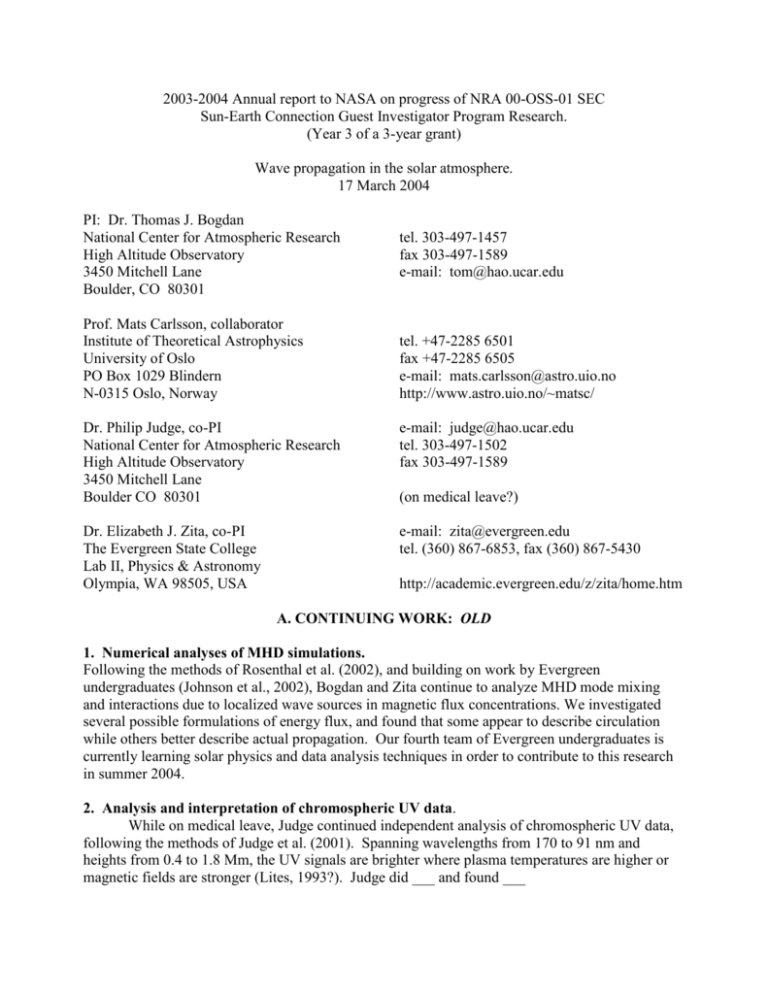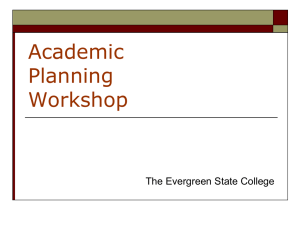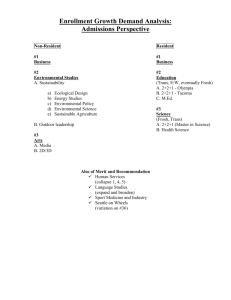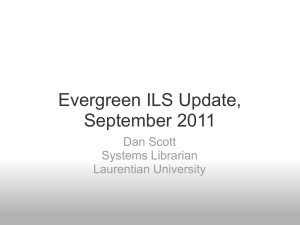NASA2003 - Academic Program Pages at Evergreen
advertisement

2003-2004 Annual report to NASA on progress of NRA 00-OSS-01 SEC Sun-Earth Connection Guest Investigator Program Research. (Year 3 of a 3-year grant) Wave propagation in the solar atmosphere. 17 March 2004 PI: Dr. Thomas J. Bogdan National Center for Atmospheric Research High Altitude Observatory 3450 Mitchell Lane Boulder, CO 80301 Prof. Mats Carlsson, collaborator Institute of Theoretical Astrophysics University of Oslo PO Box 1029 Blindern N-0315 Oslo, Norway tel. 303-497-1457 fax 303-497-1589 e-mail: tom@hao.ucar.edu tel. +47-2285 6501 fax +47-2285 6505 e-mail: mats.carlsson@astro.uio.no http://www.astro.uio.no/~matsc/ Dr. Philip Judge, co-PI National Center for Atmospheric Research High Altitude Observatory 3450 Mitchell Lane Boulder CO 80301 e-mail: judge@hao.ucar.edu tel. 303-497-1502 fax 303-497-1589 Dr. Elizabeth J. Zita, co-PI The Evergreen State College Lab II, Physics & Astronomy Olympia, WA 98505, USA e-mail: zita@evergreen.edu tel. (360) 867-6853, fax (360) 867-5430 (on medical leave?) http://academic.evergreen.edu/z/zita/home.htm A. CONTINUING WORK: OLD 1. Numerical analyses of MHD simulations. Following the methods of Rosenthal et al. (2002), and building on work by Evergreen undergraduates (Johnson et al., 2002), Bogdan and Zita continue to analyze MHD mode mixing and interactions due to localized wave sources in magnetic flux concentrations. We investigated several possible formulations of energy flux, and found that some appear to describe circulation while others better describe actual propagation. Our fourth team of Evergreen undergraduates is currently learning solar physics and data analysis techniques in order to contribute to this research in summer 2004. 2. Analysis and interpretation of chromospheric UV data. While on medical leave, Judge continued independent analysis of chromospheric UV data, following the methods of Judge et al. (2001). Spanning wavelengths from 170 to 91 nm and heights from 0.4 to 1.8 Mm, the UV signals are brighter where plasma temperatures are higher or magnetic fields are stronger (Lites, 1993?). Judge did ___ and found ___ (Here are results from last year.) (1) Power in the 2-5 mHz band appears increases with wavelength (or decrease with height) in the chromosphere (Fig.1, attached document). (2) In the 0-2 frequency range, there is consistently more power in the network (magnetic) regions than in internetwork regions. (3) In the 5-10 frequency range, there tends to be more power in the internetwork regions. 3. Comparison of observations with simulations. The UV observations in A.2 complement our simulation analyses in A.1. We compared strengths of various waves and their energy fluxes as they propagate up from the photosphere in network regions with localized radial drivers. For example, the observed decrease of p-mode power with altitude is consistent with simulations showing decreasing amplitudes of acoustic waves in the chromosphere, even when they steepen into shocks. Higher amplitudes of magnetic waves in the simulations indicate that acoustic oscillations mode-convert to MHD waves, especially near =1 regions. Simulations show clear evidence of magnetosonic waves propagating across penumbral wings of network regions, consistent with observations of running penumbral waves. Simulations also show clear evidence of excitation of Alfvénic, magnetosonic, and hybrid MHD waves, The extent to which these waves carry significant energy to higher altitudes depends on resolving the question of circulating flux versus propagating flux, noted in A.1. Synthesizing simulation analyses and data analyses contributes to our development of a clearer understanding of mode interactions and the possible role of magnetic waves in heating the chromosphere. B. NEW WORK During 2002-03, Zita synthesized results from Evergreen students’ analyses of simulation data in summer 2001 (Johnson et al. 2002) and observational data in summer 2002 (Heller et al. 2003), which are documented in our previous annual reports to NASA. Zita presented the synthesis at the AGU meeting in Dec.2003. In academic year 2003-04, a new team of Evergreen undergraduates is learning solar physics by reading the papers above and supporting articles. Zita provided these learning opportunities, including workshops and tutorials, while on unpaid leave in fall 2003. Our research team met for a week of planning and work in Oslo in Sept.2003. Bogdan facilitated a discussion of our new ApJ paper, and led our planning activities. We agreed to a list of future analyses and decided who will be responsible for each task. These are listed in D. Future Plans below. Carlsson and colleagues at ITA provided access to their complete set of simulation data and IDL analysis programs, to share with Evergreen undergraduates. Zita learned new techniques for analyzing these data, and began writing new code to carry out our plans for Evergreen’s contribution to our continued work, focusing on energy flux analyses and the generation of (k) diagrams from simulations. We have completed the establishment of a basic solar physics research infrastructure at Evergreen. With the help of technicians at the Computer Applications Laboratory on campus, we have expressly dedicated a public Linux workstation to our research, in a homeroom set aside for advanced physics students. (Unfortunately, Windows is the primary operating system on campus.) All the simulation data and analysis programs from Bogdan and Carlsson have been downloaded to this workstation, together with Zita’s new codes. New research students have learned Linux, IDL, LaTex, and are already modifying existing programs and practicing with data analysis, in preparation for our coming research summer. The homeroom also houses a growing library of solar physics texts and technical manuals, including tutorials written by Evergreen alums for undergraduates following their footsteps Bogdan finished his two-year tour of duty at NSF in October 2003, and has returned to HAO/NCAR. He continues to analyze simulation data and to advise the Evergreen team on our work. (More about your new work, Tom…). ________________________________________________________ Tom: Should we include discussions of Mats’ work? C. DISSEMINATION New publications resulting from this past year’s work include Bogdan et al. (Ap.J., 2003) Articles by Mats? (I have his list) Articles by Phil (should we include?) The simulation analyses of the first team of Evergreen undergraduates in summer 2001 are documented in our 2001 NASA report and detailed in their paper (Johnson et al., 2002). The observational data analyses of the summer 2002 team is documented in last year’s NASA report and detailed in Heller et al., 2003. The synthesis of these works is documented on Zita’s research page at Evergreen, and has been incorporated into colleagues’ publications above. Articles such as these serve as important resources in training successive teams of Evergreen undergraduate research students. Zita continues to give presentations about astronomy and solar physics research, at a reduced rate while on leave in Fall 2003. Outreach in the first half of the 2003-2004 academic year included four talks at Olympia high schools, a workshop for middle school girls at Expanding Your Horizons, and the AGU poster in SF. Bogdan has presented our joint solar physics research at (lots and lots of meetings) …. Mats Carlsson presented research results at … Judge is still on medical leave, and writing articles from home, based on analysis of chromospheric UV data. D. FUTURE PLANS In our team planning meeting in Oslo in Sept. 2003, we agreed to the following six new tasks. Tom, insert your list, or I will reconstruct from my notes… The Evergreen team’s ability to complete our share of the tasks (in energy flux analysis and (k) diagrams) depends on future funding, as our current grant expires in May.2004. The steps below may help provide some of the required resources for our future work: No-cost extension of current NASA grant through summer 2004 New proposals to funding agencies, including (paste new NASA proposal number) If these resources become available, Zita and two Evergreen undergraduates plan to work at HAO again for part of summer 2004. As the Evergreen team has learned the skills and established the local infrastructure to more independently fulfill our commitments to our joint research activities, we may spend less time in Boulder and more time working in Olympia. As discussed in B. above, students are currently working on simulation data analysis at Evergreen, at a slower pace during the academic year, when we all have full-time commitments to classes. Bogdan has been invited to visit Evergreen for another public presentation in spring 2004, and to meet with our student candidates for summer research. We will continue documenting our work with posters, presentations, and internal papers by the Evergreen team and refereed journal articles by Bogdan and co-PIs. If our research is funded for the next three years, it is time for Zita and the Evergreen team to turn our internal papers into refereed journal articles. References: Bogdan, T.J., Carlsson, M, Hansteen, V., McMurray, A, Rosenthal, C.S., *Johnson, M., *PettyPowell, S., Zita, E.J., Stein, R.F., McIntosh, S.W., Nordlund, Å., 2003, “Waves in the magnetized solar atmosphere II: waves from localized sources in magnetic flux concentrations”, ApJ 597 Bogdan et al., AGU poster T.J. Bogdan, C.S. Rosenthal, M. Carlsson, V. Hansteen, A. McMurry, E.J. Zita, M. Johnson, S. Petty-Powell, S.W. McIntosh, A. Nordlund, R.F. Stein, and S.B.F. Dorch, Astronomische Nachrichten, 323(3-4), 196-202, 2002. N. Heller and E.J. Zita, Chromospheric UV emissions: frequency spectra in network and internetwork regions, 2003, linked at http://academic.evergreen.edu/z/zita/research.htm N. Heller and E.J. Zita, Chromospheric UV oscillations depend on altitude and local magnetic field, poster presented at SHINE workshop in Banff, Aug 2002, linked at http://academic.evergreen.edu/z/zita/research.htm M. Johnson and S. Petty-Powell, Energy transport by waves above the photosphere: numerical simulations, 2002 http://academic.evergreen.edu/z/zita/students/matt/mattmhd.pdf M. Johnson and S. Petty-Powell, Magnetic energy transformations in the solar atmosphere: numerical results, 2001, http://online.itp.ucsb.edu/online/solar_c02/p_johnson/ P.G Judge, T.D Tarbell and K. Wilhelm, 2001, A Study of Chromospheric Oscillations using the SOHO and TRACE spacecraft, Astrophysical Journal 554, 424 C.S. Rosenthal and T.J. Bogdan, 2002 Astrophysical Journal 564, pp. 08-52, Waves in the Magnetized Solar Atmosphere. I. Basic Processes and Internetwork Oscillations E.J. Zita, Magnetic Waves in Sheared Field Regions, poster presented at SHINE workshop in Banff, Aug 2002, linked at http://academic.evergreen.edu/z/zita/research.htm E.J. Zita, MHD waves in a sheared magnetic field, 2003, paper linked at http://academic.evergreen.edu/z/zita/research.htm Zita et al, AGU poster TIMELINE – NOT FOR PUBLICATION spring 2000?: Zita visited HAO, Tom wrote our first proposal Summer 2001: HAO with Matt and Sara yielded Johnson et al. 2001 Summer 2002: HAO with Noah and AB yielded Heller et al. 2002 Summer 2003: no HAO visit. Worked with Jason and Katherine in academic year 2002-03. Zita synthesized MS simulation analyses from summer 2001 with NH data analyses from summer 2002 Fall 2003: Zita on unpaid leave: planning activities in Oslo (early Sept.) and solar physics journal club with contract students: Andrew White, Joey, Night, Chris Summer 2004: return to HAO with Chris Dove and Night Song? Jason Wall?





